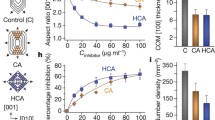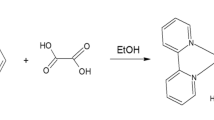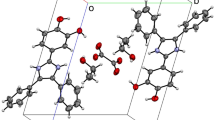Abstract
Binding of citrate and phosphocitrate to calcium oxalate monohydrate crystals has been studied using scanning electron microscopy (SEM) and molecular modeling. Phosphocitrate structure has been resolved using low temperature X-ray analysis and ab initio computational methods. The (-1 0 1) crystal surface of calcium oxalate monohydrate is involved in binding of citrate and phosphocitrate, as shown by SEM and molecular modeling. Citrate and phosphocitrate conformations and binding energies to (-1 0 1) faces have been obtained and compared to binding to another set of calcium-rich planes (0 1 0). Difference in inhibitory properties of these compounds has been attributed to better coordination of functional groups of phosphocitrate with calcium ions in (-1 0 1). Relevance of this study to design of new calcium oxalate monohydrate inhibitors is discussed.
Similar content being viewed by others
References
Richardson CF, Johnsson M, Bangash FK, Sharma VK, Sallis JD, Nancollas GH (1990) The effects of citrate and phosphocitrate on the kinetics of mineralization of calcium oxalate monohydrate. Mat Res Soc Symp Proc 174:87–92
Sallis JD, Brown MR, Parker NM (1991) Phosphorylated and nonphosphorylated carboxylic acids, influence of group substitution and comparison of compounds to phosphocitrate with respect to inhibition of calcium salt crystallization. In: Sikes CS, Wheeler AP (eds) ACS symposium series—surface reactive peptides and polymers. American Chemical Society Publishers, Washington, 149–160
Tiselius H-G, Berg C, Fornander A-M, Nilsson M-A (1993) Effects of citrate on the different phases of calcium oxalate crystallization. Scanning Microsc 7:381–390
Arnott HJ (1982) Three systems of biomineralization in plants with comments on the associated organic matrix. In: Nancollas GH (ed) Biological mineralization and demineralization. Springer-Verlag, New York, pp 199–218
Simkiss K, Wilbur KM (1989) Biomineralization, cell biology and mineral deposition. Academic Press Inc, New York
Lowenstam HA (1986) Mineralization processes in monerans and protoctists. Syst Assoc Spec 30:345–360
Wierzbicki A, Sikes CS, Madura JD, Drake B (1994) Atomic force microscopy and molecular modeling of protein and peptide binding to calcite. Calcif Tissue Int 54:133–141
Berman A, Addadi L, Weiner S (1988) Interactions of seaurchin skeleton macromolecules with growing calcite crystals—a study of intercrystalline proteins. Nature 331:546–548
Moradian-Oldak J, Frolow F, Addadi L, Weiner S (1992) Interactions between acidic matrix macromolecules and calcium phosphate ester crystals: relevance to carbonate apatite formation in biomineralization. Proc R Soc Lond B 247:47–55
Mann S, Didymus JM, Sanderson NP, Heywood BH, Samper EJA (1990) Morphological influence of functionalized and nonfunctionalized α,ω-dicarboxylates on calcite crystallization. J Chem Soc Faraday Trans 86:1873–1880
Black SN, Bromley LA, Cottier D, Davey RJ, Dobbs B, Rout JE (1991) Interactions at the organic/inorganic interface: binding motifs for phosphonates at the surface of barite crystals. J Chem Faraday Trans 87:3409–3414
Deganello S, Piro OE (1981) The crystal structure of calcium oxalate monohydrate (whewellite). N Jb Miner 2:81–88
Deganello S (1991) Interaction between nephrocalcin and calcium oxalate monohydrate: a structural study. Calcif Tissue Int 48:421–428
Sutor DJ (1969) Growth studies of calcium oxalate in the presence of various ions and compounds. B J Urol 41:171–178
Sallis JD, Lumley MF (1979) On the possible role of glycosaminoglycans as natural inhibitors of calcium oxalate stones. Invest Urol 16:296–299
Pankowski AH, Meehan JD, Sallis JD (1994) Synthesis via a cyclic dioxatrichloro-phosphorane of 1,3-dibenzyl-2-phosphonoxy citrate. Tetrahedron Lett 35:927–930
Madura JD, Wierzbicki A, Harrington JP, Maughon RH, Raymond JA, Sikes CS (1994) Interactions of the D- and L-forms of winter flounder antifreeze peptide with the [201] planes of ice. JACS 116:417–418
Tazzoli V, Domeneghetti C (1980) The crystal structures of whewellite and weddellite: re-examination and comparison. Am Mineral 65:3027–334
Glusker JP (1980) Citrate conformation and chelation: enzymatic implications. Acc Chem Res 13:345–352
Chirlian LE, Francl MM (1987) Atomic charges derived from electrostatic potentials: a detailed study. J Computational Chem 8:894–905
Breneman CM, Wiberg KB (1990) Determining atom-centered monopoles from molecular electrostatic potentials: the need for high sampling density in formamide conformational analysis. J Computational Chem 11:361–373
Dewar MJS, Thiel W (1977) Ground states of molecules 38. The MNDO method: approximations and parameters. JACS 99:4899–4906
Hirst DM (1990) A computational approach to chemistry. Blackwell Scientific, Boston
Hehre WJ, Radom L, Schleyer VR, Pople JA (1986) Ab initio molecular orbital theory. Wiley and Sons, New York
Stout GH, Jensen LH (1989) X-ray structure determination: a practical guide. Wiley and Sons, New York
Main P, Fiske SJ, Hull SE, Lessinger L, Germain G, Declercq J-P, Woolfson WM (1980) MULTAN80. A system of computer programs for the automatic solution of crystal structures from x-ray diffraction data. University of York, England and Louvain, Belgium
International tables for x-ray crystallography, vol IV (1974) Kynoch Press, Birmingham, UK
Frenz BA (1982) SDP. The Enraf-Nonius CAD-4 structure determination program—a real-time system for concurrent x-ray data collection and crystal structure solution. In: Schenk H, Oltholf-Hazekamp R, van Koningsveld H, Bassi GC (eds) Computing in crystallography. Delft University Press, Delft, The Netherlands
Author information
Authors and Affiliations
Rights and permissions
About this article
Cite this article
Wierzbicki, A., Sikes, C.S., Sallis, J.D. et al. Scanning electron microscopy and molecular modeling of inhibition of calcium oxalate monohydrate crystal growth by citrate and phosphocitrate. Calcif Tissue Int 56, 297–304 (1995). https://doi.org/10.1007/BF00318050
Received:
Accepted:
Issue Date:
DOI: https://doi.org/10.1007/BF00318050




